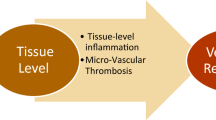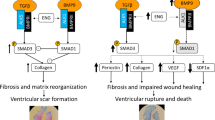Abstract
Recently, we proposed the hypothesis that a vicious cycle exists in human hibernating myocardium (HM) between the progression of myocyte degeneration and the development of fibrosis [1]. We now investigated the pathomechanism of this cycle in more detail and established a correlation between the severity of the morphological changes and the degree of postoperative functional recovery of HM.
HM was diagnosed by dobutamine echocardiography, thallium-201 scintigraphy and radionuclide ventriculography. Functional recovery was present at 3 months after coronary bypass surgery but remained unchanged at 15 months. Forty patients were subdivided into 2 groups: A with complete and B with incomplete recovery. Biopsies taken during surgery and studied by electron microscopy, immunocytochemistry, rt-PCR, and morphometry revealed myocyte degeneration and inflammatory and fibrinogenic changes in a widened interstitial space. We report here for the first time an upregulation of TGF-β1 evident by a 5-fold increase of fibroblasts and macrophages exhibiting a TGF-β1 content 3-fold larger than in control, and a > 3-fold increase in TGF-β1 mRNA by rt-PCR. The number of angiotensin converting enzyme (ACE) containing structures was increased (n/mm2: control - 11.4, A - 17.6, B - 19.2, control vs. A and B, p < 0.05). Fibrosis was more severe in group B than A or control (%: C - 10.1; A - 21.2; B - 40.6; p < 0.05). Capillary density was significantly reduced (n/mm2: C - 1152; A - 782; B - 579, p < 0.05) and intercapillary distance was widened (μm: C - 29.5, A - 36.1, B - 43.3, p < 0.05). The number of CD 3 (n/mm2: C - 5.0; A - 9.6; B - 9.4, ns) and CD 68 positive cells (n/mm2: C - 37.2; A - 80.7; B - 55.0, C vs. A p < 0.05) was elevated in HM as compared to control indicating an inflammatory reaction. Cut-off points for functional recovery are fibrosis > 32%, capillary density < 660/mm2 and intercapillary distance > 39.0 μm.
In HM a self-perpetuating vicious cycle of tissue alterations leads to progressive replacement fibrosis and continuous intracellular degeneration which should be interrupted by early revascularization.
Similar content being viewed by others
References
Elsässer A, Schlepper M, Zimmermann R, Klövekorn WP, Schaper J: The extracellular matrix in hibernating myocardium–a significant factor causing structural defects and cardiac dysfunction. Mol Cell Biochem 186: 147-158, 1998
Rahimtoola SH: The hibernating myocardium. Am Heart J 117: 211-221, 1989
Rahimtoola SH: The hibernating myocardium in ischaemia and congestive heart failure. Eur Heart J 14: 212-220, 1993
Vanoverschelde JL, Wijns W, Borgers M, Heyndrickx G, Depré C, Flameng W, Melin JA: Chronic myocardial hibernation in humans. From bedside to bench. Circulation 95: 1961-1971, 1997
Camici PG, Wijns W, Borgers M, deSilva R, Ferrari R, Knuuti J, Lammertsma AA, Liedtke AJ, Paternostro G, Vatner SF: Pathophysiological mechanisms of chronic reversible left ventricular dysfunction due to coronary artery disease (hibernating myocardium). Circulation 96: 3205-3214, 1997
Wijns WW, Vatner SF, Camici PG: Hibernating myocardium. N Engl J Med 339: 173-181, 1998
Elsässer A, Schlepper M, Klövekorn W-P, Cai WJ, Zimmermann R, Müller K-D, Strasser R, Kostin S, Gagel C, Münkel B, Schaper W, Schaper J: Hibernating myocardium–an incomplete adaptation to ischemia. Circulation 96: 2920-2931, 1997
Standke R, Hör G, Maul FD: Fully automated sectorial equilibrium radionuclide ventriculography. Proposal of a method for routine use: exercise and follow-up. Eur J Nucl Med 8: 77-83, 1983
Honig CR, Gayeski TE: Capillary reserve and tissue oxygen transport in normal and hypertrophied hearts. Perspect Cardiovasc Res 8: 249-260, 1983
Kostin S, Hein S, Bauer EP, Schaper J: Spatiotemporal development and distribution of intercellular junctions in adult rat cardiomyocytes in culture. Circ Res 85: 154-167, 1999
Chomczynski P, Sacchi N: Single step method of RNA isolation by acid guanidinium thiocyanate-phenol-chloroform extraction. Anal Biochem 162: 156-159, 1987
Brand T, Schneider MD: The TGF-β superfamily in myocardium: Ligands, receptors, transduction, and function. J Moll Cell Cardiol 27: 5-18, 1995
Weber KT: Cardiac interstitium in health and disease: The fibrillar collagen network. J Am Coll Cardiol 13: 1637-1652, 1989
Weber KT, Janicki JS, Shroff SG, Pick R, Chen RM, Bashey RI: Collagen remodeling of the pressure-overloaded, hypertrophied nonhuman primate myocardium. Circ Res 62: 757-765, 1988
Sun Y, Weber KT: Angiotensin converting enzyme and myofibroblasts during tissue repair in the rat heart. J Moll Cell Cardiol 28: 851-858, 1996
Weber KT: Extracellular matrix remodeling in heart failure. Circulation 96: 4065-4082, 1997
Moncada S, Higgs EA: Molecular mechanisms and therapeutic strategies related to nitric oxide. FASEB J 9: 1319-1330, 1995
Maes A, Flameng W, Nuyts J, Borgers M, Shivalkar B, Ausma J, Bormans G, Schiepers C, Deroo M, Mortelmans L: Histological alterations in chronically hypoperfused myocardium-correlation with PET findings. Circulation 90: 735-745, 1994
Dakik HA, Howell JF, Lawrie GM, Espada R, Weilbaecher DG, He ZX, Mahmarian JJ, Verani MS: Assessment of myocardial viability with 99mTc-sestamibi tomography before coronary bypass graft surgery: Correlation with histopathology and postoperative improvement in cardiac function. Circulation 96: 2892-2898, 1997
Depre C, Vanoverschelde JL, Melin JA, Borgers M, Bol A, Dion R, Wijns W: Structural and metabolic correlates of the reversibility of chronic left ventricular ischemic dysfunction in humans. Am J Physiol 268: 1265-1275, 1995
Author information
Authors and Affiliations
Rights and permissions
About this article
Cite this article
Elsässer, A., Decker, E., Kostin, S. et al. A self-perpetuating vicious cycle of tissue damage in human hibernating myocardium. Mol Cell Biochem 213, 17–28 (2000). https://doi.org/10.1023/A:1007182617215
Issue Date:
DOI: https://doi.org/10.1023/A:1007182617215




